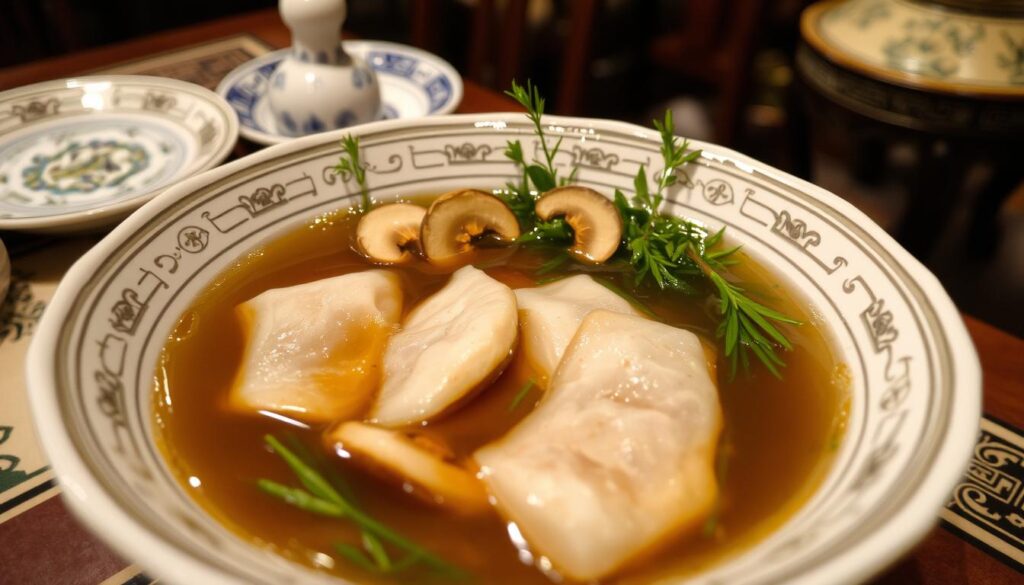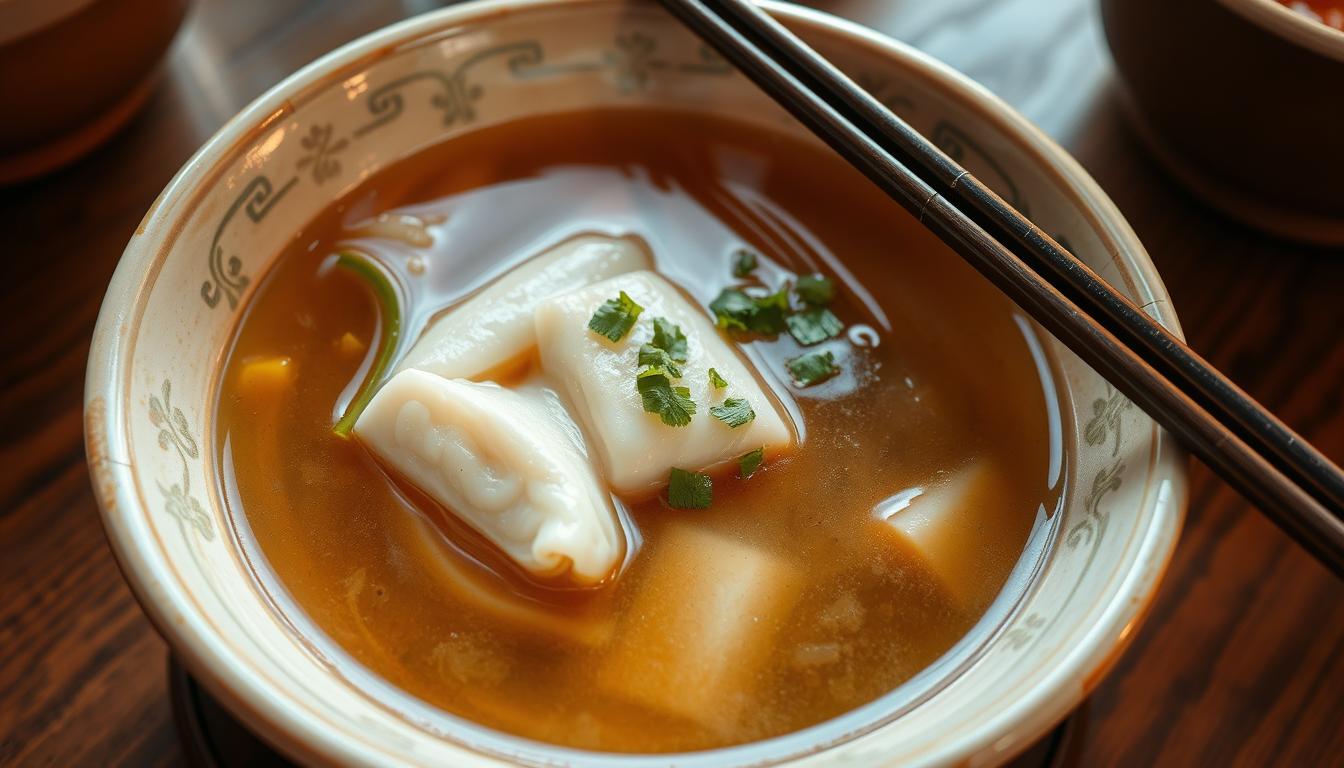When I smell the broth and fish maw cooking, I feel a wave of nostalgia. My grandmother used to make this Chinese dish, a tradition that has lasted for generations. The creamy texture and flavors of fish maw soup remind me of our family gatherings.
Sharing a bowl of this soup was a way to connect with our cultural heritage. It was a simple yet meaningful act that brought us closer together.
Table of Contents
Understanding Fish Maw: From Swim Bladder to Delicacy
Discover the fascinating story of fish maw, a treasured ingredient in Asian cooking. Known as ‘魚肚’ in Chinese, it comes from the dried swim bladder of fish like the Yellow Croaker. This delicacy adds a unique texture and can soak up flavors, making it great for many dishes.
What is Fish Maw?
Fish maw isn’t filled with urine, contrary to some beliefs. It’s actually filled with gas that helps fish stay buoyant. This dried swim bladder is prized in Asian cooking for its soft texture and ability to absorb flavors.
Nutritional Benefits and Properties
Fish maw is packed with nutrients like protein, calcium, and vitamins A, B1, B2, B12, niacin, phosphorus, and iron. It’s also rich in collagen, which is good for skin and joints. Plus, it’s low in fat, making it a smart choice for those watching their diet.
Types and Grades of Fish Maw
Fish maw comes in two forms: fried and dried. Dried fish maw is considered the better quality. Its quality is judged by thickness, size, appearance, color, and smell. The type and grade of fish maw affect its price and quality.
| Brand | Customer Rating | Specialty |
|---|---|---|
| Tong Kee Seafood | 4.8/5 | Culinary professionals and enthusiasts |
| Hong Kong Gourmet Food Co. | 4.6/5 | Health-conscious consumers |
| Dragon Chef Delicacies | N/A | Sustainable sourcing and premium quality seafood |
Dried fish maw is a favorite in Asian cooking. It’s loved by both chefs and food lovers for its unique qualities and versatility.

The Cultural Significance of Fish Maw in Asian Cuisine
In the vibrant tapestry of Asian cuisine, fish maw soup is a cherished dish. It’s a staple at special occasions, especially during the Lunar New Year. This dish is loved for its nourishing qualities and cultural importance.
Fish maw, the dried swim bladder of certain fish, is highly valued. It’s seen as a luxury ingredient in many Asian cultures. It’s celebrated for making dishes more flavorful and textured, from soups to stir-fries.
“Fish maw is not just a delicacy; it’s a symbol of prosperity and good fortune in Chinese culture. Its inclusion in celebratory meals reflects the deep-rooted appreciation for its nourishing qualities and cultural significance.”
The use of fish maw in Asian cuisine shows the region’s rich food heritage. It highlights the respect for traditional cooking methods. The way it’s prepared and used in dishes shows the skill and knowledge passed down through generations.

From the rich broth of Cantonese-style fish maw soup to the delicate texture of Shanghainese stews, fish maw adds elegance. Its lasting popularity in Asian kitchens proves its allure and nutritional value.
Essential Ingredients for Authentic Fish Maw Soup
To make a true Chinese fish maw soup, picking the right ingredients is key. The star is dried fish maw, which gives the soup its unique texture and flavor. Aromatics and optional add-ins also play a big role in making this dish special.
Main Components
Here are the main parts of fish maw soup:
- Dried fish maw: This dried, rehydrated fish bladder makes the soup gelatinous and flavorful.
- Fresh white fish: Mild-tasting fish like halibut or cod add substance and balance.
- Chicken stock: A rich chicken broth is the soup’s base, adding savory flavor.
- Crab meat: Tender crab meat adds sweetness and luxury.
- Egg whites: Whisked egg whites make the broth velvety and smooth.
Seasonings and Aromatics
Seasonings and aromatics balance the flavors and make the soup better:
- Ginger: Fresh ginger adds warmth and a spicy kick, tenderizing the fish maw.
- Green onions: Both parts of the onion add fragrance and a hint of onion flavor.
- White pepper: A bit of white pepper adds heat and depth.
- Salt: Salt brings out the natural flavors of the ingredients.
Optional Add-ins
You can also add optional ingredients to make the soup your own:
- Tofu: Soft tofu cubes add texture and a mild flavor.
- Napa cabbage: Shredded cabbage adds crunch and freshness.
- Goji berries: These berries add sweetness and color.
- Tomatoes: Cherry or diced tomatoes brighten the flavor.
By choosing and balancing these ingredients, you can make a delicious Chinese fish maw soup. It will take you straight to the heart of Asian cooking.
Proper Preparation Techniques for Dried Fish Maw
Dried fish maw is a key ingredient in Asian cooking, especially in fish maw soup. To make it soft and ready for cooking, follow these steps:
- Soak the dried fish maw in cold water for at least 4 hours, or overnight. This step rehydrates the maw and softens it.
- Steam the fish maw for 15-20 minutes after soaking. This step further softens the maw.
- Soak the fish maw in cold water for 24 hours, changing the water every 2-3 hours. This long soak makes the maw fully rehydrated.
- Steam the fish maw again for 15-20 minutes after soaking.
- Soak the steamed fish maw in ice water for another 24 hours. This step gives the maw its soft, supple texture.
By following these steps, you can turn dried fish maw into a culinary delight. It’s ready to be used in many fish maw recipes and dishes.
| Preparation Step | Duration |
|---|---|
| Initial Soaking | 4 hours to overnight |
| Steaming | 15-20 minutes |
| Soaking in Cold Water | 24 hours |
| Second Steaming | 15-20 minutes |
| Final Soaking in Ice Water | 24 hours |
By following this detailed preparation process, your dried fish maw will be soft, supple, and ready to shine in your next dish.
Creating the Perfect Fish Maw Soup Base
Making the perfect fish maw soup begins with the broth. To get the milky white and rich broth, you need to master the stock. Chicken bones and fish maw are the secrets to a comforting soup.
Stock Preparation Methods
Start with homemade chicken stock for the best fish maw soup. Simmer chicken bones, green onions, and ginger in water for hours. This makes a flavorful broth that’s the soup’s foundation.
Achieving the Signature Milky White Broth
- The milky white broth comes from mixing fish oils and bones over high heat.
- No dairy is needed; the soup’s creaminess comes from fish maw and chicken bones’ collagen and gelatin.
- Simmering fish maw in the broth slowly releases its nutrients and thickens the soup, making it luxurious.
Mastering the stock and using fish maw makes a fish maw soup that looks great and tastes authentic. It’s also collagen-rich and nourishing.
Step-by-Step Cooking Process
Making a real Chinese fish maw soup is a fun journey of flavors and textures. Follow these easy steps to make a warm bowl of this Asian classic.
- Begin by getting the fish maw ready. Soak the dried fish maw in cool water for at least 8 hours. It should soften and grow. Drain and rinse it, then blanch it in boiling water for 2-3 minutes to clean it.
- Next, boil chicken broth or stock in a big pot. Add the blanched fish maw and simmer for 15-20 minutes. It should become tender and spongy.
- Add some flavor with ginger, garlic, and dried mushrooms. You can also add crab meat, prawns, or abalone for more taste.
- To thicken the soup, mix cornstarch with a bit of water. Slowly add the slurry to the soup, stirring constantly until it’s right.
- Lastly, add beaten egg whites slowly while stirring. This will make the soup creamy and add a special texture.
Enjoy your Chinese fish maw soup hot, topped with fresh coriander or spring onions. The rich broth, soft fish maw, and seafood make it a cozy and fulfilling meal.
Getting good at fish maw soup takes practice. But with a bit of effort, you can impress your loved ones with this traditional dish.
Regional Variations and Styles
The traditional chinese fish maw soup is loved across Asia. But, recipes vary by region. The Cantonese and Shanghainese styles are two notable examples of this traditional Chinese delicacy.
Cantonese Style
In Cantonese fish maw soup, crab meat and egg whites are added. This mix creates a rich, creamy texture. It perfectly complements the fish maw’s mild flavor. The Cantonese version is famous for its balanced taste, pleasing everyone.
Shanghainese Version
The Shanghainese fish maw soup is called the “Old Shanghainese Style Fish Maw Borscht Soup.” It’s heartier, with beef brisket, Chinese sausage, and veggies like potatoes and cabbage. This version is a comforting, nourishing soup that highlights chinese fish maw soup‘s versatility.
“The regional variations in fish maw soup recipes reflect the richness and diversity of Chinese culinary traditions. Each style offers its own distinct personality, catering to a wide range of preferences and palates.”
Health Benefits and Traditional Chinese Medicine Perspective
Fish maw soup is a traditional Chinese dish loved for its health benefits. It’s rich in collagen and helps new mothers produce milk. It also warms the body and adds essential nutrients, making it great for balance and energy.
In Traditional Chinese Medicine, fish maw supports kidney energy. This is important for reproductive health and overall well-being, especially for menopausal women and the elderly. The soup’s ingredients, like white fish, ginger, and spring onions, boost immunity and improve digestion. They also reduce inflammation, helping with overall wellness.
Traditional Chinese Medicine sees food as medicine. Fish maw soup is a perfect example. It’s safe for most people, but those with fish allergies or on certain medications should talk to a TCM practitioner or doctor first.
When enjoying this soup, remember the quality of ingredients and how it’s prepared. A simple recipe uses 500g white fish fillets, ginger, spring onions, and optional goji berries. It’s simmered for about 30 minutes, showing how easy it is to make.
By using TCM and understanding fish maw soup’s health benefits, you can improve your well-being. Enjoying this traditional dish can be a tasty way to boost your vitality and find balance.
Serving Suggestions and Accompaniments
Enjoying a steaming bowl of fish maw soup is a true delight in Asian cuisine. This traditional dish is often savored during special occasions like Chinese New Year or weddings. It can be served in various ways to complement your meal.
Fish maw soup is typically enjoyed as a starter or a main course. The gelatinous and flavorful broth pairs beautifully with jasmine rice or delicate noodles. Some diners even add a dash of red vinegar to the soup for an extra burst of flavor.
To create a more substantial meal, consider pairing your fish maw soup with Dried Scallops and Egg White Fried Rice. The interplay of textures and flavors will ensure a harmonious and satisfying dining experience.
Remember, the key to enjoying fish maw soup is to relish its delicate and nourishing nature. Savor the soup on its own or as part of a larger Chinese-inspired feast. Let the flavors transport you to the heart of Asian culinary traditions.
Common Mistakes to Avoid When Making Fish Maw Soup
Making the perfect fish maw soup needs focus and knowing the right ingredients. This traditional dish is a favorite in Asia, but there are common mistakes to avoid. Here are some tips to make your chinese fish maw soup perfect every time.
Temperature Control Tips
Keeping the right temperature is key when cooking fish maw. If the soup boils too hard, the fish maw can become mushy. Instead, use low heat and let the soup simmer slowly. This way, you get the best flavor without ruining the fish maw.
Texture and Consistency Guidelines
Getting the right texture and consistency in your fish maw soup is crucial. The fish maw should be soft but still have a bit of chew. If it’s overcooked, the soup will be too thick. If it’s undercooked, it will be tough. Finding the perfect balance takes time and patience, but it’s worth it.
- Make sure the fish maw is well rehydrated before adding it to the soup
- Simmer the soup gently, letting the fish maw slowly release its flavors and textures
- Watch the consistency closely and adjust the cooking time as needed to get the desired texture
Mastering temperature control and texture will help you make a fish maw soup that looks great and tastes amazing. With practice, you’ll be able to make this traditional dish perfectly every time.
Conclusion
Exploring the world of fish maw soup has been a joy. It shows how versatile and healthy this Asian favorite is. Whether you want a cozy meal or a special treat, this fish maw soup will please your taste buds and boost your health.
Fish maw soup started in China but is loved everywhere. It’s packed with proteins, omega-3s, and collagen. This makes it more than just tasty; it’s also super good for you.
Ready to try fish maw soup yourself? We hope you’ll love its history, cooking methods, and the pleasure of eating it. Enjoy your meal!

